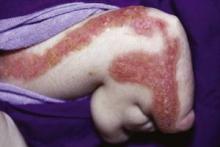LISBON – A new topical approach to the treatment of the cutaneous abnormalities of a rare inherited disorder of lipid metabolism is drawing rave reviews from other genodermatosis experts.
"It’s a simple idea, but I think it’s a genius approach," Dr. Thomas Schwarz said at the annual congress of the European Academy of Dermatology and Venereology.
He was referring to a recent report by Dr. Amy S. Paller and her coworkers in which they described their successful reversal of the skin manifestations of congenital hemidysplasia with ichthyosiform erythroderma and limb defects (CHILD) syndrome in two patients having the X-linked dominant disorder of distal cholesterol metabolism.
The group, led by Dr. Paller, professor and chair of the department of dermatology at Northwestern University, Chicago, accomplished this by determining that the dry, ichthyosiform appearance of the skin in patients with CHILD syndrome is from a deficiency of cholesterol in the skin, with resultant accumulation of toxic metabolites.
"It’s a simple idea, but I think it’s a genius approach."
They opted to address this not through gene therapy, but via topical therapy with lovastatin and cholesterol. Topical lovastatin was used to block the aberrant mevalonate pathway, thereby curbing production of the toxic metabolic intermediates, and topical cholesterol was used to replace the missing lipid in the skin.
The result was clearance of the skin lesions by 3 months. This was accompanied by ultrastructural evidence indicative of normalization of epidermal structure and lipid secretion in affected skin (J. Invest. Dermatol. 2011;131:2242-8).
The brilliance of this approach lies in the fact that Dr. Paller and her coworkers were able to bypass gene therapy, said Dr. Schwarz. Gene therapy is the focus of much of the research effort aimed at developing new therapies for genodermatoses, but it is proving technically daunting and costly, and progress has been slow.
"They’ve shown you don’t need to correct the gene defect; you can just supplement what the gene is not doing. I think this is very exciting. It’s going to have a significant impact, because there are many other genodermatoses with distal defects in cholesterol metabolism," said Dr. Schwarz, director of the department of dermatology, allergy, and venereology at the University Hospital in Kiel, Germany.
Other genodermatoses where a similar therapeutic approach deserves study are X-linkedrecessive ichthyosis, Sjögren-Larsson syndrome, Conradi-Hünermann-Happle syndrome, Refsum disease, and Chanarin-Dorfman syndrome, he added.
Dr. Schwarz said he had no relevant financial disclosures.


